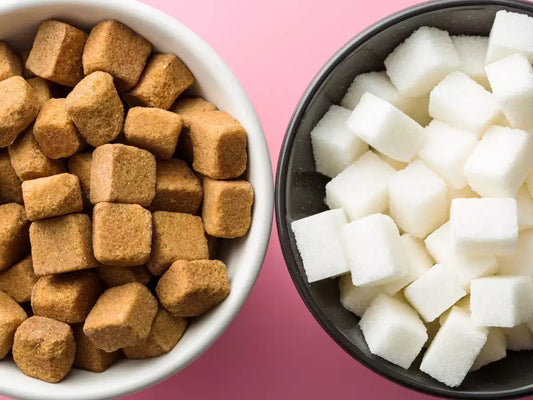When it comes to sweeteners, health-conscious individuals often find themselves confused between brown sugar and white sugar. Nowadays, there are different types of sweeteners available in the market, ranging from sugar-free healthy alternatives to artificial sweeteners. However, it causes lots of chaos among people about which one to include in their diet. So, let’s explore the brown sugar vs. white sugar comparison.
The basics: brown sugar vs. white sugar
Brown sugar and white sugar both originate from either sugarcane or sugar beets. However, their differences lie in the way they are processed and composed.
Processing
During the production process, there is a crucial step that involves separating sugar crystals from molasses. Molasses sugar refers to a thick and dark brown syrup naturally found in sugar beet and sugar cane plants.
White sugar undergoes extensive refining and processing to remove molasses and impurities, resulting in the creation of crystalline, granulated sugar. This processed form is widely used in coffee and baking applications.
In contrast, brown sugar retains its molasses content, infusing it with a distinct flavour and colour. The presence of this molasses gives brown sugar its signature slightly caramel taste and deeper hue.

Nutritional differences
White and brown sugar have almost similar calorie contents. Brown sugar contains approximately 380 calories per 100 grams, while white sugar has around 385 calories per 100 grams.
When considering the nutritional content, brown sugar has a slight advantage. It contains more calcium, with 83 milligrams per 100 grams, compared to just 1 milligram per 100 grams in white sugar. Additionally, brown sugar has slightly higher amounts of minerals like iron.
It's worth noting that the differences in mineral content become insignificant when considering the small amounts typically used in recipes. Both brown and white sugar are often referred to as "empty calories," lacking significant nutritional value.
The Dietary Guidelines for Americans recommend limiting added sugar intake to less than 10% of daily calorie consumption. If you consume 2,000 calories daily, you should not consume more than 200 calories from added sugars. A helpful approximation is about 12 teaspoons of sugar.
Culinary uses
White and brown sugar each have unique culinary applications. While they can be used interchangeably at times, it's important to consider that such substitution may affect the colour, flavour, and texture of your food.
Brown sugar possesses a remarkable ability to retain moisture due to its molasses content. When added to recipes, it tends to yield baked goods that are soft and dense in texture. For example, cookies made with brown sugar acquire a moist and chewy quality. In contrast, the use of white sugar contributes to baked goods that rise more, allowing more air into the dough and resulting in a lighter, airier texture.
In recipes that require adequate rising, white sugar takes the stage. It especially shines in delicate treats like meringues, mousses, souffles, and other fluffy baked goods. The ability of white sugar to create a light and airy texture makes it an ideal choice for these confections.
On the other hand, when it comes to recipes that require a denser texture like zucchini bread and rich, chewy cookies, brown sugar takes the lead. Its unique properties enhance the flavours of these irresistible delights.

Conclusion
Brown sugar is often preferred over white sugar due to its higher calcium content. It's essential to note that both types of sugar primarily contribute to the taste and texture of baked goods, providing limited nutritional benefits. Therefore, following the advice of the U.S. government is advisable. They recommend restricting added sugar intake to no more than 10% of daily calorie consumption.
For individuals seeking to create healthier sweet treats, there are nutritious alternatives available. Two excellent options include erythritol and stevia sugar, which provide sweetness without the added calories. Another approach is to add mashed fruit or cinnamon into baking as substitutes for traditional sugars. Not only do these substitutions cater to a sweet tooth, but they also align with a more health-conscious approach to baking and cooking.


